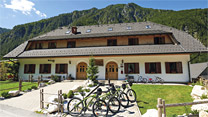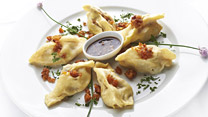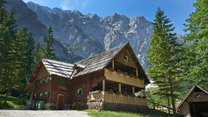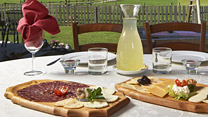Traditional dishes
ZGORNJESAVINJSKI ŽELODEC
Zgornjesavinski zelodec (Upper Savinja pork stomach) is a culinary speciality of the Upper Savinja valley. It consists of top-quality, geographically protected dried meat produced from the quality meat and bacon of locally-reared pigs. It has been produced based on a special process on farms in the Upper Savinja valley for centuries. Although in the past Upper Savinja pork stomach was only served on special occasions and holidays, it is now served, cut into thin slices, as an appetiser or light lunch at many tourist farms and in some restaurants in the Savinja valley.

SOLČAVSKI SIRNEK
Sirnek is a mature lightly salted curd cheese with cumin, to which fresh cream is added prior to serving. It is made by lightly salting fresh curd cheese from skimmed milk, adding cumin and placing it in a clean container. The curd is squeezed well and covered with a clean gauze. The curd is then left to mature for 14 to 21 days, and sometimes even up to 2 months or more. The maturing time depends on the temperature and how spicy the product is. Maturation should not take place at too high temperatures, e.g. room temperature, as it leads to water being separated. If maturation takes place at too low a temperature, it becomes bitter, its structure is not correct and it has an unpleasant smell. During maturing, the cheese is stirred occasionally and a small amount of fresh curd cheese is added. The structure of properly matured sirnek must be firm and not greasy.
Sirnek is the basis for the extremely tasty sirnica cheese ‘soup’, inherited from the past and still very popular in Solčava today.

MASOVNIK
Masovnik is a traditional dish of flour cooked with butter and cream.
The cream is first bought to the boil over a low heat. Flour is added to the cream then hot milk is poured over the mixture whilst stirring at all times. Stir until butter is eliminated from the mixture and a compact mass is formed which separates in the pan. Masovnik is eaten with black bread and white coffee.
The ratio of the ingredients should be two parts cream to one part flour and one part milk.

GRUŠAVI ŽLINKROFI
Grušavi žlinkrofi are small dumplings filled with dried pears.
The dried pears are cooked in a small amount of water until soft. The stalks and pips are removed then the pears are ground. Eggs and breadcrumbs or bread are added to the mixture.
A dough is formed from the ingredients (flour, egg, a little milk and a little oil), which is softer than past dough. Small loaf shapes are formed, which are then covered and left to rest. Each individual ‘loaf’ of dough is rolled out and small balls of the filling mixture are placed in rows about 3cm apart. Another piece of dough is placed on top then it is cut into squares. The dumplings are pinched to seal them and the shape of a cockerel is made in the middle.
Cover them with breadcrumbs fried in fat or cheese, when they turn yellow, add a teaspoon of honey, mix quickly and immediately pour over the pasta.

SKIPNEKI
Skipneki are pieces of leavened dough that are boiled then fried and covered with hot fat.
Leavened dough is prepared then left to rest and rise. The dough is lightly shaped into long, two-finger-thick sausages, which are cut in 10cm lengths. The dough is covered and left to rise again. Once risen, the pieces of dough are simmered in boiling salted water with the upper (nicely risen) side in the water. The pan is covered and the dough is simmered gently for up to three minutes, then the cover is removed, the pieces of dough are turned and simmered for a few more minutes. Care should be taken not to overcook the pieces of dough otherwise they deflate and lose their traditional skipnik shape. The cooked dough is then put into a hot pan or baking tray and hot fat is poured over.
They make an ideal accompaniment to venison or beef.

PUTRTOHI
Putrtohi are buttered, leavened round pastries.
The well-leavened dough is made then lightly rolled out to the thickness of two fingers and shaped into rounds and left to rise. Once risen the rounds are brushed with a mixture of beaten egg with a teaspoon of cream.
Putrtohi were once considered an excellent dessert – a real treat. Today, they are eaten as a snack or for breakfast, preferably with butter and honey.























